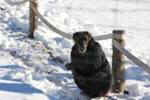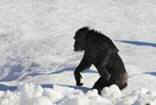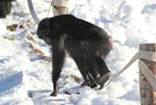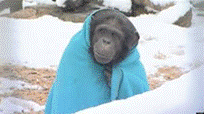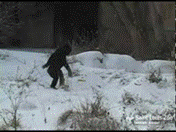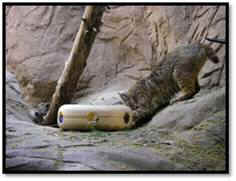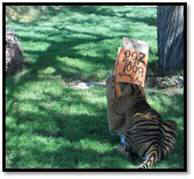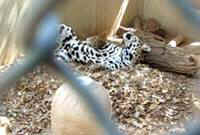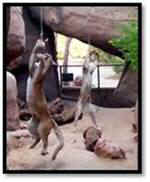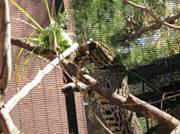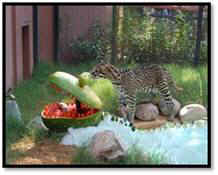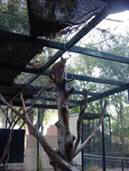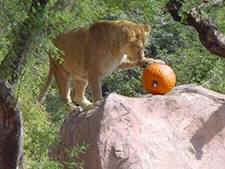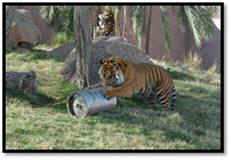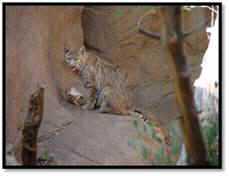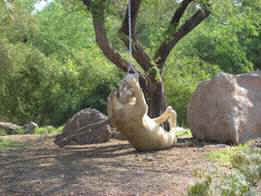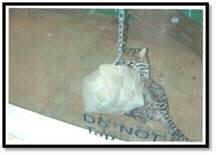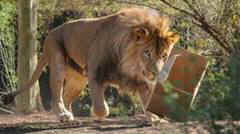|
Rostov
Zoo, Russia Report
January
22-28, 2016
GOALS
To
introduce Doroty (approximately 4.5 – 5 year old female
infant) to any other chimpanzee, as well as
to see if the chimpanzees could be regrouped. To
give suggestions regarding basic husbandry, enrichment,
training or behavioral issues for any other species in the
collection. To hold a webinar about chimpanzee
behavior and the Phoenix Zoo’s contra freeloading
program.
Chimpanzees
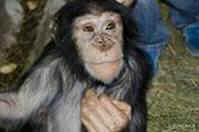
Doroty
(Dora) - 2011 – unknown |
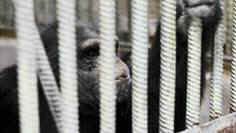
Toto
- 1996 - P.t. verus |
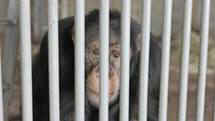
Tayson
- 2006-P.t. verus |
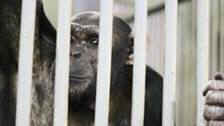
Mikl
(Michael)- 2005 - P.t. verus
|
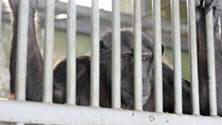
Elis
-1991-P.t. schweinfurthii
|
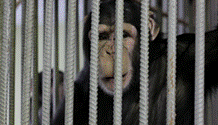
Haus
- 2010 - P.t. schweinfurthii x P.t. troglodites |
Doroty
and her brother
Along
with her brother, Doroty was purchased from poachers by a
private owner. They were originally given to the Kazan Zoo,
which retains legal ownership. After a while, the
siblings were separated because Doroty was
stunted in her growth (she looked like she was approximately
two-years-old), didn’t appear to use her legs very well,
and had limited social skills. Consequently, staff was
concerned about her not being able to protect herself from
her brother.
Doroty
was loaned to the Rostov Zoo and hand-reared by the primate
manager and her family in a cage modified to be a nursery
which was inside the chimpanzee building.
The
plan was to slowly introduce her to six-year-old juvenile,
Haus, and then later to adult female, Elis, and
possibly to early adolescent male,Tayson, since Elis and
Tayson have been housed
together
and got along well with each other.
The
plan couldn’t procced because Doroty had a piece of wire
in her neck (under her skin), a possible remain
from a snare or other capturing or restraining device of the
poachers. The consultant felt that
the wire needed to be removed prior to any introductions to
avoid probable injury in the future.
In
the meantime, Doroty’s resocialization has started. Haus
(who was also being hand-reared by the primate manger)
was easily separated from early adolescent Mikl and was
walked by hand next to Doroty daily. He spent a half a
day being “howdied” with Doroty and then he was put back
with Mikl in the afternoon. Haus could approach her
through a small tunnel and she could climb up and meet him
sitting on a metal bench. Staff needed to stay with the
infants at all times in case Haus accidentally punched
Doroty’s wire, if she fell
the wrong way during playing through the bars, or if Haus
would try to take out the wire from her body. Since
the tunnel that connected the two cages was about five feet
high (1.5m), Doroty was forced to use her limbs extensively.
By the second day, she was clearly holding the bars with her
feet and was able to thrust her body upwards. It is most
likely that soon she will be able to use her legs properly
or at least satisfactorily.
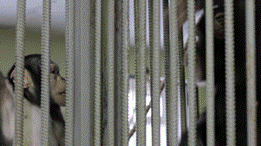
Suggestions:
Every attempt should be made to transfer Dorothy’s
brother from Kazan to Rostov and either reunite the
siblings or introduce him to other chimpanzees. This male is
only an Infant and should not be kept in solitary
confinement.
The
Rostov Zoo (as a leading zoo in Russia) also should try to
communicate with other zoos and discourage illegal animal
trading. No follow up information yet.
Changes
after consultation:
It was confirmed on April 8, 2016 that Doroty was operated
on. Email follow up on”
Friday,
April 08, 2016 4:22 AM “About Doroty. We've operated her.
And now she is in the rehab period. Everything is fine! I'll
send you some
photos
of our new enclosure for small carnivores soon”.
After her recovery, Doroty should be introduced as the
original plan suggested above. Introducing her to
other chimpanzees should be priority since she spends
approximately14-15 hours alone after staff is gone and also
that she would develop her proper chimpanzee social
behaviors instead of relating to humans. Once her legs are
working satisfactorily (she will use them
for running, climbing, holding objects, etc.), she can be
introduced to Haus and then to the surrogate parents.
Again, this step
should be pursued as fast as her development allows it. Infant
chimpanzees will not learn proper behaviors if
the adults, especially the mothers or surrogate mothers, are
not present. In the wild, mothers are the main
teachers of all survival skills up until the infants reach
about eight years of age.
Instructions
of introducing Dorothy to Haus and then to Mikl was
provided. No follow up information yet.
Doroty’s
nursery should be a chimpanzee nursery and not a human one.
Most human toys, blankets, etc., should be
removed and the cage filled with substrate, ropes, hanging
object, sleeping devices such a hammock, or
baskets to promote developing proper motor skills. All
objects should be elevated (especially nests)
since chimpanzees (as per their natural
behaviors) do not feel safe sleeping/resting on ground, and
also because chimpanzees spend more than half of their
daily budget (59 percent) off the ground.
Changes
after consultation: Dora’s
cage was modified already to better suit her needs and to
help to develop her motor skills.
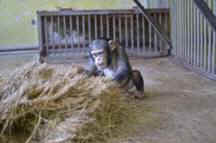
“How
do chimpanzees spend their time?” – instead of “What
chimpanzees do?”
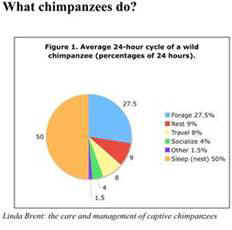
It
is imperative that proper nesting materials (leafy branches,
paper products, edible dry leaves, etc.) are provided daily
for learning how to build a nest.Chimpanzees rest in
incredible heights (30-50”) up in the canopy:
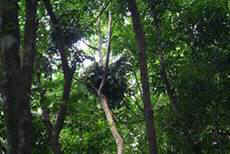
http://www.youtube.com/watch?v=Olbrzuz2ot0&feature=related
http://www.youtube.com/watch?v=VoiUtT0TslE&feature=related
In
captivity chimpanzees should at least be provided with:
Elevated
structures
|
Beds/Baskets |
Sleeping
platforms |
Hammocks |
 |
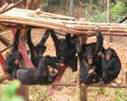 |
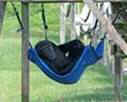 |
Nesting
materials
If
elevated structures cannot be provided, substrates need to
be added on grounds for
nest building. Please compare resting without and with
substrate. No follow up information yet.
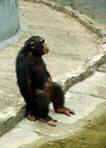
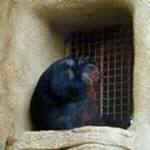 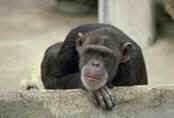
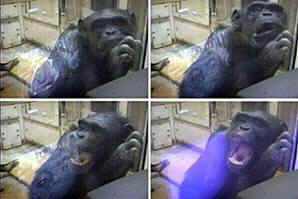
|
Shredded
paper |
Excelsior |
Wrapping
paper |
 |
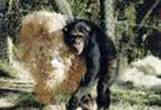 |
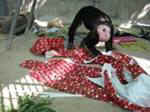 |
|
Clothing |
Hay/straw |
Browse |
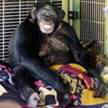 |
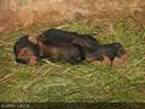 |
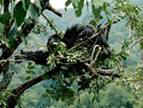 |
|
Dry
leaves |
Natural
soil |
grass
and vegetation |
 |
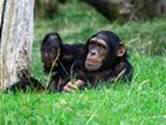 |
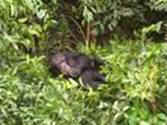 |
Winter
care
The
chimpanzees are usually locked inside for 3-4 months during
wintertime.
Chimpanzees
can be allowed outside for limited time during the winter.
However, they need to have access to
inside heat and provided with extra blankets. Some
institutions keep a temperature guideline and will only
let
their
chimpanzees out if the temperature reaches 10-13 degrees
Celsius. Others, such as Chimpanzee
Sanctuary
Northwest, USA, allow the chimpanzees to make their own
decision. It is important to remember to provide chimpanzees
the opportunity to seek warmth if allowed outdoor access
during cold weather, and there might
be a temperature below which outdoor
access is inappropriate. The only time they
don't allow them outside is when heavy, wet snow
reduces the voltage on their electric fence.
Chimpanzees
in the snow
See-through
curtains made from heavy-duty plastic strips can be hung
inside the night houses to keep the animals
warm. Management must take into consideration the type of
enclosure, the animals’ behavior and
characteristics,
the materials used, if it would prevent the animals from
exiting or entering the enclosure, etc.
Suggestions:
The method used by the Chester Zoo in England is simple. Strips
of thick, clear ARCO PVC
are
cut to the length of the slide and holes are drilled in the
PVC. A strong, thick metal plate, which has
the same amount of holes drilled in it, is lined up and
bolted onto the wall. This makes it a lot easier to take
off and replace broken or torn PVC strips.
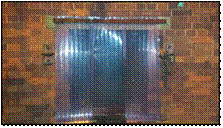
OTHER
SPECIES
Solitary
Primates
Several
primate species were kept on bare concrete and also in
solitary confinement.
Social isolation and reduced space allowance have been documented to
cause increased levels of aggression and stress levels in a
range of
captive wild animals from primates to dolphins.
Orangutan
There was a female orangutan kept in solitary
confinement and on concrete, inactive most of the times due
to lack of stimulation.
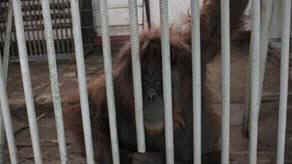
Suggestions:
It is a misconception that orangutans live in solitude in
the wild.
Orangutan
Social Life
They
also keep in very large groups in captivity in the Orangutan
Foundation International, Borneo. It
would be in the best interest of the animal if she was
introduced to another orangutan as soon as
possible.If
the Rostov Zoo cannot acquire another specimen from another
accredited institution, then this animal should be
transferred to another zoo or sanctuary and taken out of
solitude.
About
Dr. Mary Galdikas Birute
Dr.
Birute's Research
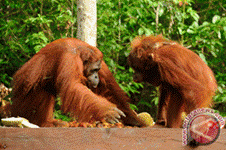 
Ring-Tailed
lemur introduction
Male
and female ring-tailed lemurs (Lemur catta) were
housed separately because of their age differences.
However,
due to the large importance of keeping social animals in
group settings, an introduction was attempted and it
went well.
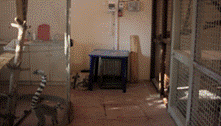 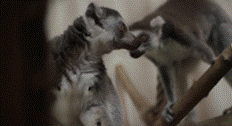
Changes
after consultation: lemurs received substrate as well.
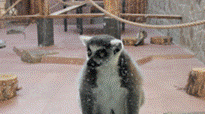 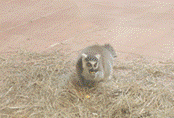
Suggestions:
Solitary
primates need to be able to see, smell and touch other
primates, even if it is a different species,
until
they are paired up with their conspecific. Please consider
these laws and guidelines
regarding
social keeping of primates –
Title
9, Code of Federal Regulations, Subchapter A – Animal
Welfare Part 3 Standards, Subpart D Specifications for
the Humane Handling, Care, Treatment, and Transportation of
Nonhuman Primates,
Sec.
3.81 Environment enhancement to promote psychological well-being.Dealers,
exhibitors, and research facilities must develop,
document, and follow an appropriate plan for environment
enhancement adequate to promote the psychological
well-being of nonhuman primates.
The
plan must be in accordance with the currently accepted
professional standards as cited in appropriate
professional
journals or reference guides, and as directed by the
attending veterinarian.
This
plan must be made available to APHIS upon request,
and, in the case of research facilities, to officials of any
pertinent funding agency. The plan, at a minimum, must
address each of the following:
(a)
Social
grouping. The environment enhancement plan must include
specific provisions to address
the
social needs of nonhuman primates of species known to exist
in social groups in nature.Individually
housed nonhuman primates must be able to see and
hear nonhuman primates of their own or compatible species
unless the attending veterinarian determines that it would
endanger their health, safety, or well-being.
Canadian
Council on Animal Care, Olfert ED, Cross BM, McWilliam AA1993.
Guide
to the Care and Use of Experimental Animals, Volume 1,
2nd Edition.
Canadian
Council on Animal Care, Ottawa
"The social needs of animals used in research,
teaching, or testing, should be
given
equal consideration with environmental factors
such as lighting, heating, ventilations and
containment (caging). Particularly in the case of singly
housed animals, daily observation
provides
an alternative from of social contact for the animal and commonly
facilitates handling in that the animal becomes
accustomed
to
the human presence. .. Most
animals should not be housed singly unless
required by medical condition, aggression, or dictates of
the study. Singly housed
animals should have
some
degree of social contact with others of their own kind. ...
In
the interest of well-being, a social environment is desired
for each animal which will
allow
basic social contacts and positive social relationships.
Social behaviour assists
animals
to cope with circumstances of confinement."
European
Commission 2002.
The Welfare of Non-human Primates - Report of the
Scientific Committeon Animal Health and Animal Welfare.
European Commission, Strasbourg, France
http://europa.eu.int/comm/food/fs/sc/scah/out83_en.pdf
"Primates should not be
housed singly unless fully justified by health
considerations (for the animal and human
handler) or research procedures, as advised following an
ethical review process. If primates have to be singly
housed, the animals should have visual,
olfactory and autitory contact with
conspecifics.”
International
Primatological Society 1993.
IPS
International guidelines for the acquisition, care and
breeding of
nonhuman
primates, Codes of Practice 1-3. Primate Report 35, 3-29
" A compatible conspecific probably provides more
appropriate stimulation to a captive primate than any other
potential environmental enrichment factor. ... Monkeys
should, unless there are compelling reasons for not doing
so, be housed socially. ...
Young monkey should not normally be separated from its
mother at an early age (i.e., at 3-6 months) but
should remain in contact for one year to 18 months, in most
species.
There is unlikely to be any
greater
productivity through early weaning, in seasonally breeding
species, such as rhesus monkeys. Even in non-seasonal
breeders, any slight increase in productivity must be offset
against the resulting behavioural
abnormalities of the offspring."
National
Research Council 1996.
Guide
for the Care and Use of Laboratory Animals, 7th Edition.
National
Academy Press, Washington
"Animals should be housed with the goal of
maximizing species-specific behaviors and minimizing
stress-induced
behaviors.
For social species, this normally requires housing in
compatible pairs or groups."
National
Research Council 1998.
The
Psychological Well-Being of Nonhuman Primates.
National Academy Press, Washington
"Social interactions are considered to be one of the
most important factors influencing the psychological
well-being of most nonhuman primates. ... The common
practice of housing rhesus monkeys
singly
calls for special attention [p. 99] ...
Every effort should be made to
house these [singly caged] animals socially (in groups or
pairs),
but when this is not possible, the need for single housing should
be documented by investigators and approved by the IACUC. ... The animal
technician's and caregiver's roles are pivotal to the social support of primates,
particularly animals that are singly caged."
Vervet
monkey introduction
Female
vervet monkey was found in a small cage inside a much larger
exhibit due to being displaced and injured
by her conspecifics constantly. It was a good effort to
prevent solitary confinement, however, the cage
was too small to house an animal for the rest of her life
and she still spent much of her time alone.
It was suggested that she should be introduced to the adult
male of the group who formed a good relationship with
her in the past and then they will be moved to the much
larger cage that was now empty after the lemur introduction.
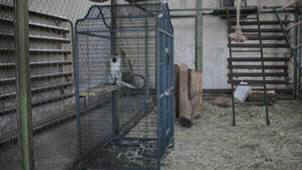
Changes
after consultation:
Vervet
monkeys were introduced and moved into much larger empty
lemur cage. They received substrate and enrichment.
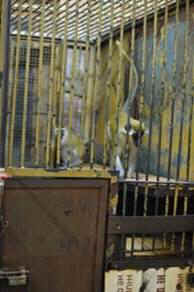 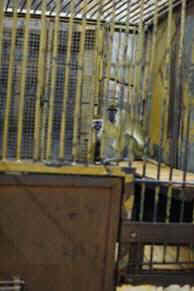
GENERAL PROPOSALS
Small
concrete cages and exhibits, off-exhibit areas and correct
substrate use
Special
attention needs to be paid to all the small enclosures,
night houses and other off- exhibit holding
areas, where animals spend an average 14-17 hours in
concrete/bar cages or situations where
an animal needs to be kept isolated for any reason. Although
hoof stock were kept in large exhibits,
many animals (mostly carnivores, birds and primates) were
housed on sterile surfaces either
outside in freezing temperature (-17C; 1.4F) or locked
inside into extremely small areas with reduced
chance for exploratory behaviours. This practice creates
poor mental and physical conditions
for the animals.
Suggestions:
Continuing
to keep animals off of very hot or very cold, persistently
wet, unyielding surfaces
(brick,
concrete, etc.) would be desirable. The use of appropriate
substrate (inside- paper
products,
hay or straw, etc.; outside- nonflammable materials such as
grass, sand, soil,
mulch, fresh browse, etc.) will make a significant
difference not only in the animals’ health but also in
improvement of the exhibit aesthetics.
Mixed
Species Exhibits
Suggestions:
Mixed species exhibits can be created in order to free up
space and create a more esthetic, complex exhibit. This will
also immediately resolve some of the solitary (otherwise
social) species problems until they are paired up with their
conspecific.
Please
review some photos of Phoenix Zoo mixed exhibits. No follow
up information yet.
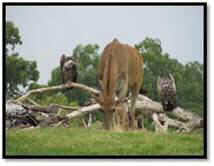 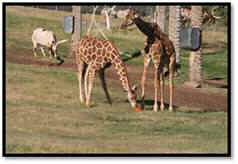
Extending
Foraging Time
Animals
were generally found to be bored in their cages, not being
able to carry out species-appropriate behaviors,
particularly foraging. Most species ate for a short period
of time only. They spent the rest of the time being inactive
or exhibiting stereotypic behaviors.
Suggestions: All animals need to be fed in a way that extends
their foraging time and
encourages appropriate, species-specific behaviors. If no one
can be appointed for
this position, staff can be scheduled to cut browse and chop
diet on a rotation basis.
Contra freeloading presentation was given regarding teaching
animals how to work for
their food in captivity. No follow up information yet.
Carnivores
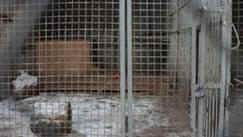 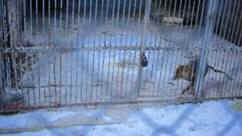
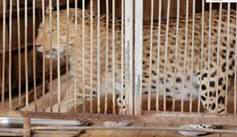
Most
carnivores were kept in empty cages and on concrete floors.
Suggestions:
Cage bottoms (similarly to hoof stock exhibits) need to be
broken off and planted with grass. Until then, about half of
the cages can be covered with various substrates such as
natural soil, edible dry leaves, hay, straw, paper, etc.
Most
carnivores were locked inside into a large Carnivore
Building with the understanding that these animals
cannot go outside due to harsh weather conditions (-17C)
because they were not cold climate species.However, African
lions that live in sub-Saharan Africa or dromedaries of
the
Sahara
Desert in Africa were kept outside and on the ice and snow
which proves these types of species
can
also go outside if acclimated well enough.
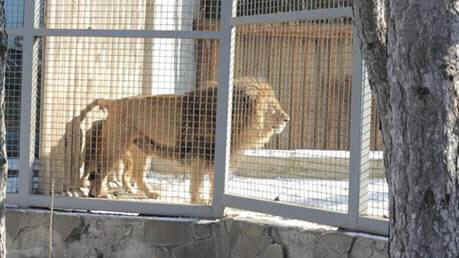
Suggestions:
All carnivores should go outside during the winter time. If
the zoo starts to let them out for shorter period of
times during fall and winter, in a few years all species
could acclimate to colder weather. Animals will need
to have access inside warm night houses, and cage floors
should be covered at least 1/3 of the areas with
deep bedding for the animals to be able to come off of the
frozen surface.
Changes
after consultation: Changes
have begun. Email follow up on 2-29-16 “We started
improving – changing the floor covering from carnivores,
the environment has enriched with cardboard boxes, wood, we
build a new enclosure for carnivores with natural
flooring.”
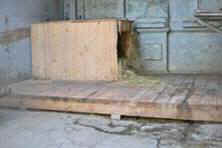 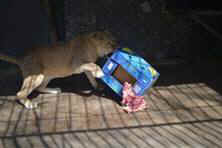
Solitary
female lion
There
was a young female in solitary confinement in a small cage
far away from a pair of lions.
Suggestions:
This animal needs to be introduced to the pair as
fast as possible. Lions
don’t do
well in solitary confinement and it would also create a much
better lion exhibit since lions, by nature, live in
prides. This would also create a better educational message
for the visitors. No follow up information yet.
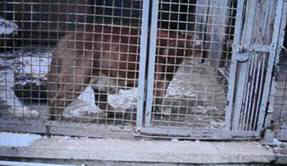
Mental
health of male Siberian tiger
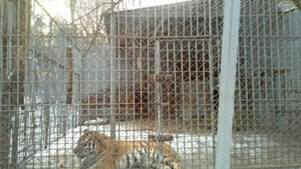
This
animal appeared to be under large distress. He was
“moaning, crying” during every night of the
consultant’s
stay from approximately 1 – 6 A.M. with very little pause.
This is not normal tiger behavior and the
consultant
addressed it immediately. At that moment the only fast
solution was to open up the empty cage next to him to
enlarge his exhibit.
Suggestions:
This animal should be transferred next to the other two
tigers as soon as possible.
The
tiger pair don’t like to go outside (for reasons unknown
to consultant) therefore their exhibit is
empty all the time. He could be alternated into this exhibit
with the pair. That would give him some activities to do and
well as encourage the other tigers to come outside and
explore his scents. Besides moving him, he will need
to receive enrichment every day. No follow up information
yet.
Lack
of behavioral enrichment
Most
animals lacked enrichment. The consultant addressed this
problem immediately, consulting with Carnivore
Manager and Curator. The “Feline Enrichment at the Phoenix
Zoo” PowerPoint presentation was given as well as an
email consultation suggesting immediate free or low cost
enrichment items that can be given straightaway.
Suggestions:
The following items could be provided immediately.
Phoenix Zoo Carnivore staff will provide a more detailed
schedule later:
·
Bones! Beef knuckle bones can keep carnivores busy for
hours and they can be left on exhibit for 1-2 days
Use of three dimensions by placing large logs, hammocks,
wooden platform, etc., all the way to the ceiling
·
Feathers
·
Seasonal fruit and vegetables
·
Substrate covering at least 1/3 of exhibits and inside
areas
·
Kegs
·
Barrels
·
Cardboard boxes
·
Phone books
·
Spices and herbs (fresh or dry)
·
Hoofstock smells (on logs, hay, etc.)
·
Fire hose and fire hose feeder devices
·
Items hung
·
Perfumes (only sprayed onto small items and then removed
after 1-2 hours)
·
Edible tree branches (even if they have no leaves)
·
Logs with bark
·
Fecal from hoofstock (previously approved by vet)
·
Urine from hoofstock (previously approved by vet)
Elephants
The
elephant program was found satisfactory with very caring,
dedicated staff trying to keep them busy while they
were
locked inside for the winter time.
Suggestions:
Elephant can go outside for certain period of time under
temperature restrictions. AZA Standards for
Elephant
Management and Care, 2012 document was provided for greater
details.
. 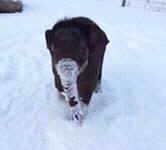 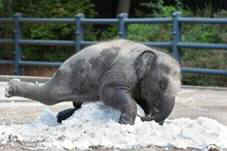 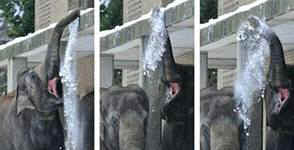 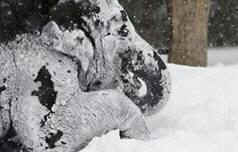
Elephants
playing on the Snow
The
building lacked proper substrates. There was a large, old
pool inside unused.
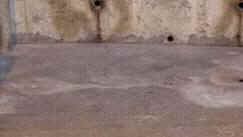 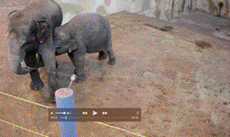
Suggestion:
Elephants need to be kept on soft surfaces. Deep (2-3 feet)
sand should
be
placed inside and outside as well as large (6-7) feet tall
sand mounds should
beprovided
for resting as well as for breaking up the monotone surface.
Staff agreed to fill large pool with sand
in the future.
Puzzle
feeders, wallows, scratching posts can be provides for
behavioral enrichment
to
extend foraging time, provide good skin care and to keep
animals busy. The Phoenix Zoo’s Elephant
Enrichment
PowerPoint presentation was shown to the elephant staff
describing how this enrichment program
helped the Phoenix Zoo to have mentally healthier elephants.
Several works of Alan Roocroft, world renowned
elephant
consultant, were provided via email such as: The Sand
Invasion, five years on, August 2011.
“Two
parts sand, one part imagination” and Foot Care for
Captive Elephants. No follow up information yet.
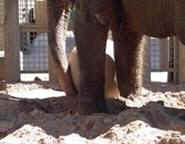  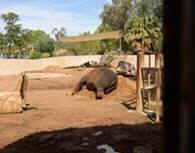 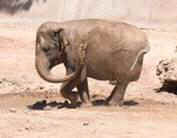
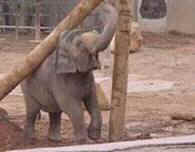
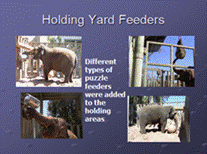 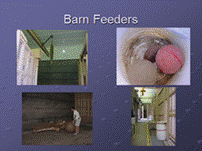
Keeper
schedule, routine
Extended
workload.
I have observed many keepers sitting around and talking,
cooking their lunch, etc., for long periods of time.
Instead, keepers could rebuild the empty cages,
add appropriate furniture, cut browse, provide enrichment,
train their animals for basic medical and husbandry
behaviors, plant edible trees inside/outside the
exhibits
for future use and shade, plant grass, paint the walls of
exhibits and night houses, etc. They
should answer the visitors' questions, talking about their
animals' ages, names, behaviors, etc. so the visitors
would start learning about them.
No follow up information yet.
EDUCATION
A
three-hour long webinar was held regarding chimpanzee care
and the Phoenix Zoo’s
contra
freeloading program with the following institutions:
·
Ekaterinburg Zoo
·
Izhevsk Zoo
·
Kazan Zoo
·
Minks Zoo
·
Seversk zoo
·
Moscow Zoo
·
Chelyabinsk Zoo
·
Karsnoyarks Zoo ‘Roev Ruchey
·
Alma-Ata Z00
Fundraisers
There
were several discussions regarding raising money for better
animal care.
Suggestions:
The zoo can do many things following the Phoenix Zoo’s
programs such
as
hosting birthday parties, weddings, breakfasts with keepers,
behind the scene tours,
keeper for a day programs, special gift making and selling
(painted eggs, animal paintings, etc.).
Nontoxic children’s paint can be used by animal artists to
create unique paintings that can be
sold
and the money go to purchasing enrichment items. Please
review below: painted chicken and ostrich eggs, animals
painting, and pigs rolling out
carpets
that can be used during weddings.
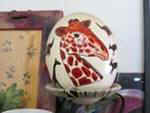  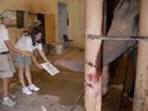
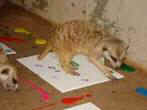
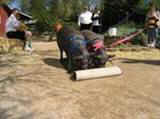 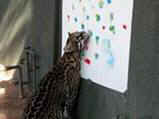
Staff
involvement in decision making and professional development
The
zoo needs to incorporate education about basic husbandry
into staff training to
have a
more qualified and knowledgeable staff.
Most staff members
under mid-management levels
are less educated, lacking essential knowledge,
and, therefore, being
underutilized.
For example, keepers were
never involved in meetings and decision making and
certainlydid not feel part
of the team.
Suggestions:
There are many ways to encourage staff to be educated and
the best way
is
to involve them and provide them with formal training. Staff
prof
is
crucial to provide quality animal care. Managers should hold
short courses about basic husbandry,
enrichment and training. Keepers should be assigned to
prepare short lectures
regarding the animals they are working with and present them
to their area keepers, developing
further
knowledge. Management can come up with some rewarding
systems such as providing
food and beverage during these educational meetings, have a
“keeper of the month,” “best
enrichment of the month,” “most creative exhibit
improvement of the month,” etc. This inclusivity
and training would boost morale, encourage keepers and
managers to be
more
involved, and improve understanding of the animals and the
best way to care for them.
The
following presentations were provided and translated to
Russian:
CHIMPANZEE:
TO UNDERSTAND, TO MENTOR, TO SAVE.
What makes chimpanzees
special, and why, more than any other species, they deserve our
special attention. I will attempt to convey the
intelligence, describe the sensitive minds, and illustrate
the social
and physical needs of the chimpanzee. By revisiting this close
relative of humans from a
different angle, I hope that all people will begin to appreciate
these animals and their
fundamental needs on a higher level.
CONTRA
FREELOADING.
A presentation teaches people how to feed their animals
so, instead
of eating, they would forage similar to their conspecifics
to the wild.
THE
LACK OF SUBSTRATE USE IN ZOOS.
Addresses the easy fix of empty cages and
shows how much of a difference it makes in the animals’
lives when they do not have
to sit in empty concrete cages. This is probably the most
important animal welfare presentation I will give.
BENEFICIAL
BROWSE.
Will show how to grow plants even in the Sonoran
Desert, and
how to create browse gardens practically from nothing under
such harsh climate
and provide edible (free) plants for the entire collection
every single day.
GROWING
GRASS IN THE DESERT ENVIRONMENT: IF
WE CAN DO IT, SO CAN YOU!
Addresses
how to create green, luscious grass fields even
in a region experiencing highly
variable
and extreme temperatures (range from 28 to 125 degrees F),
extremely low
precipitation (about 10 inches or less per year), dust
storms, and, within the Phoenix metropolitan area,
a serious heat island effect due to the urban
environment. The presentation will provide knowledge about
appropriate soil composition, compost ingredients, grass
species and their seasonal differences, dormancy and
over-seeding, irrigation techniques, maintenance
and water reuse. These applications can be
successful even in a harsh, desert climate.
IT’S
NOT ABOUT SPACE, IT’S HOW YOU USE IT: IMPROVING
AVAILABLE SPACE
WITH
ENRICHMENT AT PHOENIX ZOO
Many
zoos keep animals in very simplistic, inanimate, and basic
cages composed of nothing
more
than a concrete floor with mesh or bars, a food and water
dish, and some room on
the
floor for the animal to move around. The situation is
amplified when even adequate space is not provided.
This presentation will attempt to outline the many ways that
floor and vertical space can be enhanced in order to provide
useful habitat in all three dimensions.
Even
more, most of these ideas are free or low cost, and can be
made
from
recycling household products.
LET
THEM BE ELEPHANTS.
Describes how the Phoenix Zoos’ enrichment program
helped
us to have happier, mentally healthier Before, all these
animals did was to try to
kill each other. It also addresses some foot work to help
keep their feet in better shape and prevent the suffering
that wet concrete can cause (which includes the possibility
of early euthanasia).
ZOO
FARM ENRICHMENT AT THE PHOENIX ZOO
Farm
animal enrichment has often been neglected due to a primary
focus of zoos
in their exotic animal collections. Also, for a variety of
reasons, many people hold the view that the sole purpose of
domesticated farm animals is simply to provide
a service as food or labor; often this notion even permeates
into the zoo setting.
This
thought can create a misconception that domesticated animals
have no needs beyond
eating and drinking, that they are simple animals that lack
cognition, and cannot
suffer or feel pain, or, even worse, that it would not
matter if they could.
Any
notion that they are inferior, simple animals that can be
“kept as furniture” should
be disabused, and I urge every zoo that is not already
providing behavioral
enrichment to their farm animals to begin doing so. The
Phoenix Zoo makes it a priority to provide equal
enrichment to both domestic and exotic species. Our staff
proudly presents an example of high quality care of
their farm animals.
FREE
CHIMPANZEE ENRICHMENT
Sometimes
providing enrichment is challenging
due to a lack of an
adequate budget. However, necessity is the
mother of invention! This presentation is a collection of
enrichment ideas made from free household
products, recycled materials and donated items by the most
dedicated chimpanzee staffs around the world.
These
enrichment products provided invaluable moments for the
chimpanzees in the different zoos.
SUPPORTING
ANIMAL WELFARE AT ZOOS AROUND THE WORLD: A COLLABORATION
BETWEEN THE PHOENIX ZOO, THE JANE
GOODALL
INSTITUTE AND OTHER NON-GOVERNMENTAL ORGANIZATIONS (NGOs)
Hilda
Tresz has been an employee of the Phoenix Zoo since 1993,
and has had a volunteer affiliation
with the Jane Goodall Institute since 2007. The two
organizations support her role of traveling toselect foreign
zoos up to six weeks per year to assess and advise on animal
husbandry practices. This presentation will discuss examples
of her efforts and demonstrate a successful
collaboration between zoos and NGOs in order to
improve animal welfare.
I
would like to thank the Rostov Zoo’s director and staff
for inviting me to improve their animals’
welfare. I would also like to thank Dr. Mary
Lewis for funding this trip and Big Hearts Foundation for
establishing such a wonderful working relationship between
the Jane Goodall Institute, the Phoenix Zoo and the Rostov
Zoo.
Thanks
Hilda
Tresz
Behavioral
Enrichment & International Animal Welfare Coordinator
Mentor,
The Jane Goodall Institute
Phoenix
Zoo | Arizona Center for Nature Conservation
455
N. Galvin Parkway | Phoenix, AZ 85008
p
602.286.3800 x 7120 | d 602.286.3820
htresz@phoenixzoo.org
| phoenixzoo.org
|



























